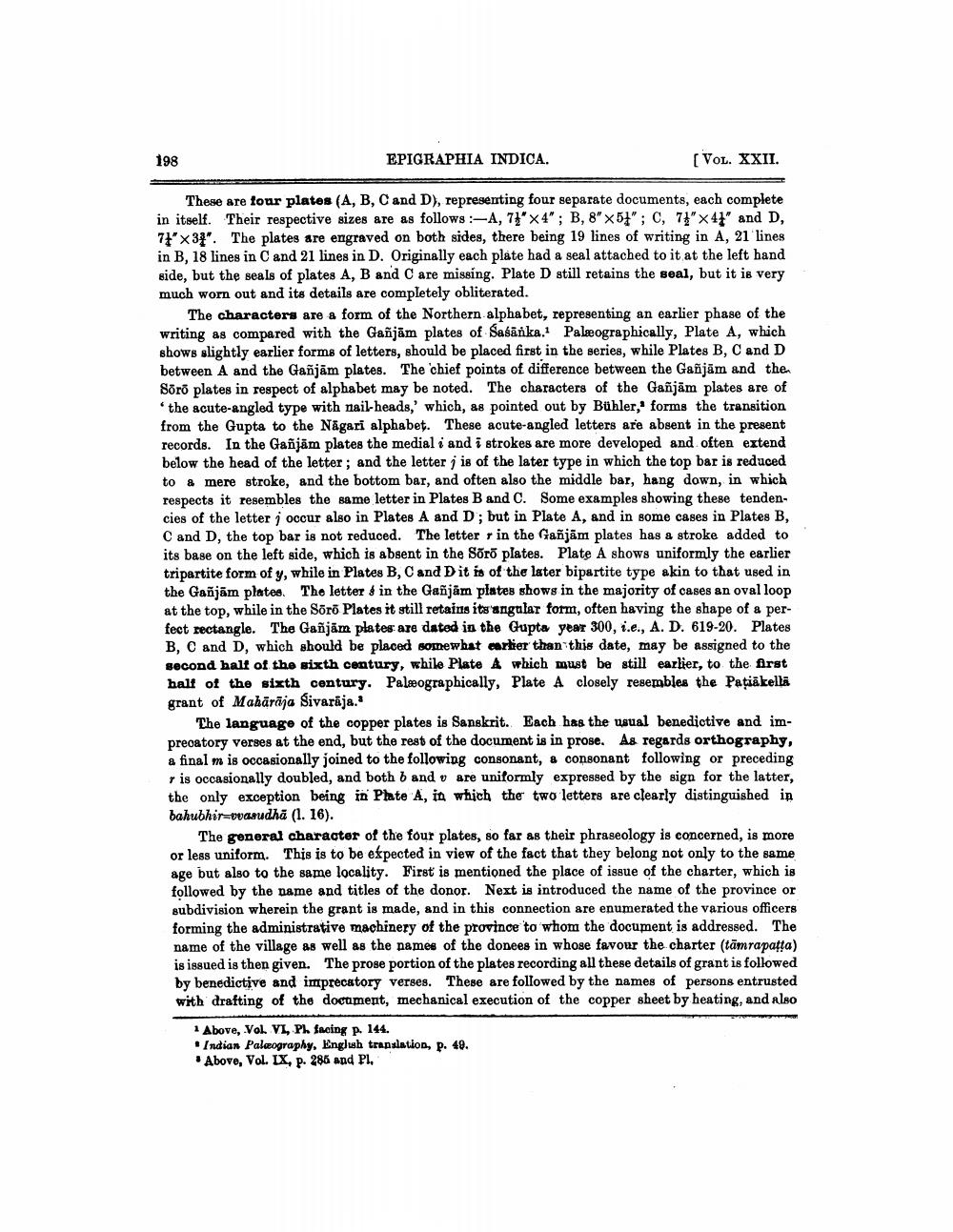________________
198
EPIGRAPHIA INDICA.
[VOL. XXII.
These are four plates (A, B, C and D), representing four separate documents, each complete in itself. Their respective sizes are as follows:-A, 7"x4"; B, 8"x5"; C, 7"x4" and D, 72"x3". The plates are engraved on both sides, there being 19 lines of writing in A, 21 lines in B, 18 lines in C and 21 lines in D. Originally each plate had a seal attached to it at the left hand side, but the seals of plates A, B and C are missing. Plate D still retains the seal, but it is very much worn out and its details are completely obliterated.
The characters are a form of the Northern alphabet, representing an earlier phase of the writing as compared with the Gañjām plates of Sasanka. Palæographically, Plate A, which shows slightly earlier forms of letters, should be placed first in the series, while Plates B, C and D between A and the Gañjām plates. The chief points of difference between the Gañjām and the Sōrō plates in respect of alphabet may be noted. The characters of the Gañjām plates are of "the acute-angled type with nail-heads,' which, as pointed out by Bühler, forms the transition from the Gupta to the Nagari alphabet. These acute-angled letters are absent in the present records. In the Gañjām plates the medial i and i strokes are more developed and often extend below the head of the letter; and the letter j is of the later type in which the top bar is reduced to a mere stroke, and the bottom bar, and often also the middle bar, hang down, in which respects it resembles the same letter in Plates B and C. Some examples showing these tendencies of the letter j occur also in Plates A and D; but in Plate A, and in some cases in Plates B, C and D, the top bar is not reduced. The letter r in the Gañjām plates has a stroke added to its base on the left side, which is absent in the Sōrō plates. Plate A shows uniformly the earlier tripartite form of y, while in Plates B, C and D it is of the later bipartite type akin to that used in the Gañjām plates. The letter & in the Gañjām plates shows in the majority of cases an oval loop at the top, while in the Sōrō Plates it still retains its angular form, often having the shape of a perfect rectangle. The Gañjām plates are dated in the Gupta year 300, i.e., A. D. 619-20. Plates B, C and D, which should be placed somewhat earlier than this date, may be assigned to the second half of the sixth century, while Plate A which must be still earlier, to the first half of the sixth century. Paleographically, Plate A closely resembles the Pațiākellā grant of Maharaja Sivarāja.
The language of the copper plates is Sanskrit. Each has the usual benedictive and imprecatory verses at the end, but the rest of the document is in prose. As regards orthography, a final m is occasionally joined to the following consonant, a consonant following or preceding r is occasionally doubled, and both b and are uniformly expressed by the sign for the latter, the only exception being in Plate A, in which the two letters are clearly distinguished in bahubhir-vvasudha (1. 16).
The general character of the four plates, so far as their phraseology is concerned, is more or less uniform. This is to be expected in view of the fact that they belong not only to the same age but also to the same locality. First is mentioned the place of issue of the charter, which is followed by the name and titles of the donor. Next is introduced the name of the province or subdivision wherein the grant is made, and in this connection are enumerated the various officers forming the administrative machinery of the province to whom the document is addressed. The name of the village as well as the names of the donees in whose favour the charter (tāmrapaṭṭa) is issued is then given. The prose portion of the plates recording all these details of grant is followed by benedictive and imprecatory verses. These are followed by the names of persons entrusted with drafting of the document, mechanical execution of the copper sheet by heating, and also
1 Above, Vol. VI, Ph. facing p. 144.
Indian Paleography, English translation, p. 49. Above, Vol. IX, p. 285 and Pl.




